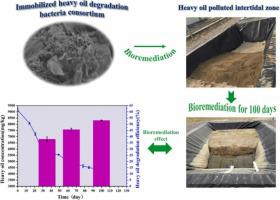Process Safety and Environmental Protection ( IF 6.9 ) Pub Date : 2021-11-27 , DOI: 10.1016/j.psep.2021.11.038 Xiaoli Dai 1 , Jing Lv 2 , Wenxia Wei 1 , Shaohui Guo 2

|
Heavy oil contamination adversely affects on the intertidal ecological environment and human health. In this study, immobilized bacterial consortium was used in remediating intertidal zones contaminated with heavy oil, and its effectiveness was investigated in simulation experiment pools constructed in the coastal areas. After 100 days, the heavy oil degradation efficiency of immobilized bacterial consortium was 52.99%, which was 13.57% and 30.61% higher than that of biostimulation and natural attenuation, respectively. The immobilized bacterial consortium significantly increased the microbial degradation activity, heavy oil-degrading microbial count, and heavy oil degradation efficiency. Gas Chromatography–Mass Spectrometry results revealed that the biodegradation efficiency of C15–C35 n-alkanes and 2–5-ring polycyclic aromatic hydrocarbons was 25.98–95.80% and 58.93–97.97%, respectively. Microbial community structural analysis showed that Acinetobacter sp. and Bacillus sp. were prominently involved in heavy oil biodegradation. Furthermore, the immobilized bacterial consortium not only resisted the invasion of adverse intertidal environment and promoted the biodegradation of heavy oil pollutants in sediments but also effectively increased the competitiveness between the indigenous oil-degrading microorganisms and other microorganisms. This study can be a promising approach to remediate heavy oil contaminated intertidal zone.
中文翻译:

固定化菌群生物修复重油污染潮间带
重油污染对潮间带生态环境和人类健康造成不利影响。本研究将固定化菌群用于修复重油污染的潮间带,并在沿海地区建造的模拟实验池中研究其有效性。100天后,固定化菌群的重油降解率为52.99%,分别比生物刺激和自然衰减的降解效率高13.57%和30.61%。固定化细菌聚生体显着提高了微生物降解活性、重油降解微生物数量和重油降解效率。气相色谱-质谱分析结果表明,C15-C35 正构烷烃和 2-5 环多环芳烃的生物降解效率分别为 25.98-95.80% 和 58.93-97.97%。微生物群落结构分析表明,不动杆菌属 和芽孢杆菌。主要参与重油生物降解。此外,固定化细菌聚生体不仅抵抗了不利的潮间带环境的入侵,促进了沉积物中重油污染物的生物降解,而且有效地增加了本土石油降解微生物与其他微生物之间的竞争力。这项研究可能是修复重油污染潮间带的一种很有前景的方法。











































 京公网安备 11010802027423号
京公网安备 11010802027423号